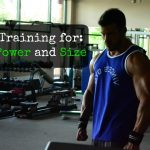Get Big and Stay Lean with Combined Training for Power and Size! – The Process
If you’ve been in the iron game for long, you’ve probably heard the mantra that you can’t get big and strong without also getting fat. Plenty of old-timers and young guns alike will shout from the hilltops that you’ve got to alternate all-out “bulking”and “cutting” phases, where you’re either blowing up with tons of food or trimming down eating like a bird. But this isn’t true at all!
Sure, you’re not going to be able to grow while maintaining the near-zero level of body fat you need for a bodybuilding show. But if you think you need to lose your abs, get a big gut and put on tons of weight just to gain muscle and strength, you’re approaching things all wrong!
Getting big while staying lean isn’t just a dietary issue, either. In fact, the right training approach can turn your body into a muscle-building, fat-burning factory that will work WITH you rather than against you! With the right combination of “traditional” bodybuilding training AND super-heavy lifting, you’ll set yourself up to become the biggest, strongest and leanest bodybuilder you can be – all in one fell swoop.
The First Step

Gaining tons of size while keeping your lines – sound too good to be true? It’s not, but there IS a catch. If you want to stay lean, you have to actually get lean first!
The problem with so many lifters and even hopeful competitive bodybuilders is that they live in this kind of “in-between” zone, around 13-15% body fat. They’re not straight-up fat by any means, and some even have some decent definition and vascularity – but they’re not truly lean from a bodybuilding standpoint. When you’re in this zone, your body just isn’t that good at nutrient partitioning, and you’ve got to watch your diet like a hawk to avoid gaining any more fat.
Once you dip in the single digits, however, your body becomes far more efficient at shuttling extra nutrients to muscle cells. Not only will your surplus calories NOT be stored as fat, you’ll actually build more muscle with the same food intake and training! And you DO need those excess calories to build muscle, by the way. We’re not talking about making meager gains on a diet, here, we’re trying to get significantly bigger without getting fatter.
So, if you want to optimize your results and build your physique as efficiently as possible, bite the bullet and get lean first. A smaller but leaner body is a much better starting point for long-term gains than a chunky or skinny-fat physique!
Power Training: Not Just for Strength!

\Forget the notion that heavy weight and super-low reps will only build strength, not size – it’s nonsense! First of all, even if lower-rep training did nothing to directly stimulate growth, it absolutely does make you stronger. A higher one-rep max allows you to lift more weight at any lower rep range, so you’ll ultimately be able to stimulate more growth with 6, 8, 10 or 12 reps. Who’s going to be bigger – the guy who can bench 225 for 10 or the guy who can bench 315 for 10? The stronger guy, every time!
Aside from the incredible indirect benefits of low-rep training, however, lifting for strength WILL put on mass! Ultimately, building muscle is a matter of the total workload your muscles receive, and you can sure as hell put in a lot of work with lower reps, IF you’re willing to do lots of sets. Most guys’ idea of power training is to work up to a shoddy-looking one-rep max on the squat or bench, and then call it a day or move onto another exercise.
What you should instead be doing is 6, 8 or even 10 sets of 3-5 reps with a very heavy weight that you can still handle with good form. This kind of training may not give you the tight, pumped feeling you get from higher reps, but all of that heavy-ass work will absolutely FORCE your body to adapt and grow. Plus, in the long run, guys that lift heavier tend to have a denser, harder, dare I say “more toned” look than bodybuilders who train purely in higher rep ranges. Wouldn’t you rather look big and dense all the time, rather than just puffing up and shrinking back down when you leave the gym?
Rep Work: The Other Piece of the Puzzle

As beneficial as low-rep training can be, you shouldn’t go the opposite direction of the bodybuilding herd and do it exclusively! Like we talked about before, getting strong in lower rep ranges won’t just stimulate growth of its own, it’ll also allow you to handle more weight with higher reps. If you want to gain maximal size and strength in the shortest amount of time, you should always be progressing in several different rep ranges.
So, what should an actual workout look like? First, focus on certain lifts. I don’t care how you arrange your overall split, just make sure each day has a main heavy movement like a squat, bench press, deadlift or overhead press. Begin by working up to your heaviest sets in your lowest rep ranges, and once you’ve done those, starting working back down in weight, doing several more work sets with less weight and more reps. Here’s an example squat day:
-Warm-ups and work-up sets
-405 x 2 sets of 4
-385 x 2 sets of 6
-365 x 2 sets of 8
-315 x 2 sets of 12
Depending on what kind of split you’re using, you might move onto other quad-dominant exercises, some hamstring work, or even some pressing or back work if you’re using a full-body routine. You might also adjust the overall number of work sets based on how often you’re doing that lift throughout the week, and how many days you’ll have before you train legs again.
But whatever you do, just make sure you’re working both lower reps and higher reps! And by “higher,” I don’t mean 15, 20 or more – I mean 8-12, the range where you’re getting winded and feeling more of a pump, but where you’re still able to use decently heavy weights. Save the really high reps for isolation work, machine exercises and other lifts where you’re not risking injury just by getting tired under the bar.
Staying Lean with Volume

There may be a few exceptions to this rule, but in general, guys who do high-volume workouts stay leaner than lifters who do short – albeit high-intensity – routines. By doing lots and lots of work with heavy weights, you place an incredible demand on your body to shuttle all those extra nutrients to your muscle cells, and a high enough workload may even stimulate a little bit of fat burning.
Don’t think that high volume means low intensity, though! The real key is to build your work capacity so that you can do lots of hard, heavy sets on the most metabolically demanding exercises. If you’re new to this type of training, then you might need to be able to get through 8 or 10 heavy sets of squats in one workout, and you’ll certainly have trouble following that up with even more accessory work. But if you build up your training volume over time WHILE increasing the weights, you’ll be amazed at how you’re able to build muscle, eat like a horse and stay lean in the process!
If you’re skeptical, just look at some of the old-time, golden era lifters like Arnold and Franco. They were lean year ’round, and they spent TONS of time in the gym! I’m not saying everything about their approach was optimal or practical, but it’s clear that large volumes of work allow you to remain lean while packing on size. Who knew that doing more work would yield better results?!











